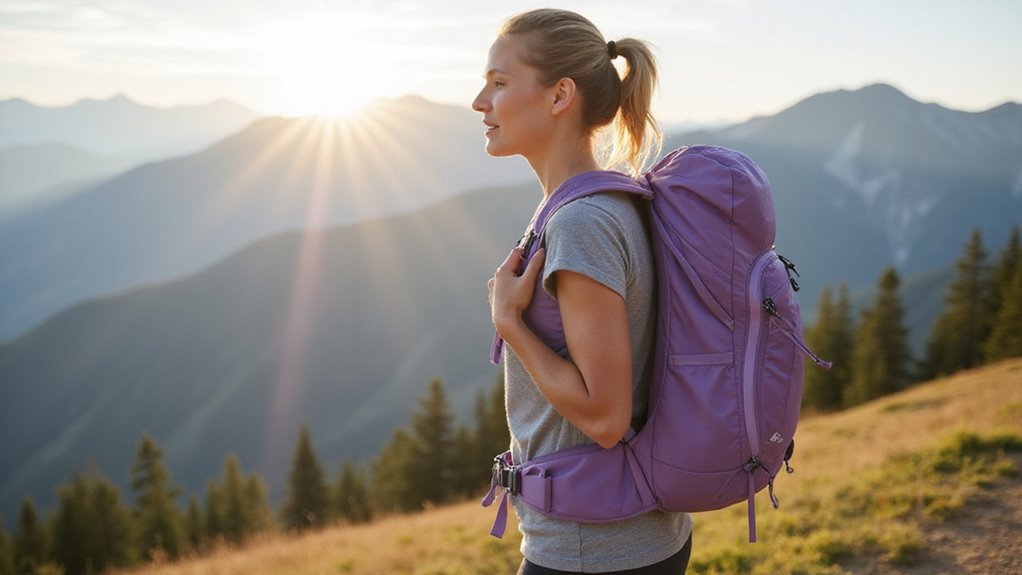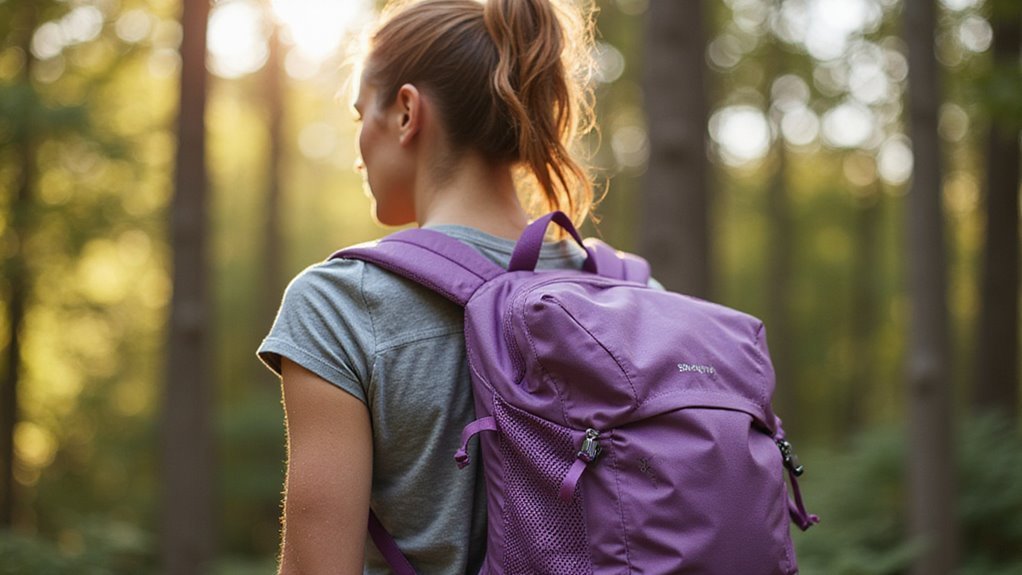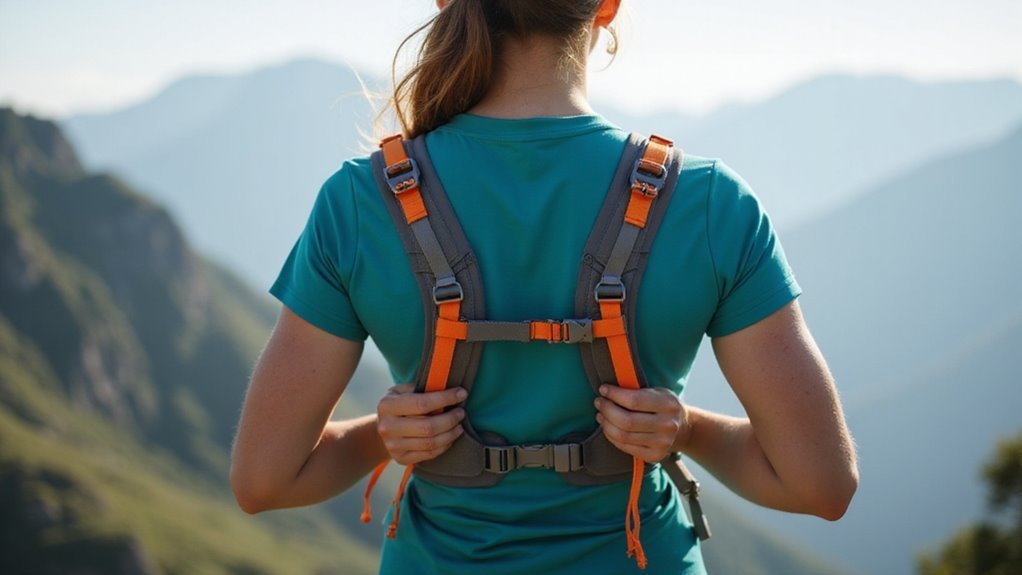Sarah’s shoulders ached for weeks after her Appalachian Trail section hike – all because she’d settled for a unisex pack that didn’t fit her frame. We’ve seen this mistake too many times. Let’s cut through the marketing fluff and get straight to what matters in women’s hiking packs: proper ergonomics, smart weight distribution, and female-specific design features. Your spine and shoulders will thank us later as we break down the top performers that actually work for women’s bodies.
Key Features of Women-Specific Pack Design

Three essential features define women-specific pack design: anatomically-tailored straps, custom torso sizing, and strategic weight distribution.
We’ve seen major advances in womens backpacks that actually work with female anatomy, not against it. The key? Ergonomic designs featuring adjustable torso length and narrower shoulder straps that won’t dig or chafe.
Smart gear organization compartments put everything you need within easy reach.
But comfort isn’t just about fit. Today’s packs nail breathability with mesh panels that keep you cool. Additionally, breathable back panels contribute to enhanced airflow and comfort during long hikes.
Load lifters and cushioned hip belts distribute weight exactly where you want it.
Finally – pockets that make sense for how we actually hike.
Finding Your Perfect Fit and Size
Success in backpack fitting starts with precise measurements – there’s no way around it.
We’ll need your torso length and hip circumference to nail the perfect fit for women’s packs designed around anatomical differences.
Look for adjustable torso features and narrower shoulder straps – they’re non-negotiable for comfort and load distribution.
Brands like Gregory and Osprey offer fit guides and expert consultations to dial in your ergonomic hiking backpack’s settings.
Load it up, take a test walk, and adjust until it feels like part of you.
Trust us: proper sizing transforms a good pack into your perfect adventure companion. Additionally, make sure to consider weight placement for optimal stability and comfort during your hikes.
Top-Rated Comfort and Support Systems

Once you’ve nailed your measurements, let’s maximize that perfect fit with cutting-edge comfort systems. The Osprey Aura AG leads with its revolutionary AntiGravity suspension system, while the Gregory Deva 70’s plush padding handles serious loads. We’re seeing groundbreaking ergonomic design across women’s hiking packs, with breathable back panels and precision torso adjustment becoming standard features. Proper weight distribution is essential for reducing strain and ensuring a comfortable hiking experience.
| Pack Model | Support System | Comfort Rating |
|---|---|---|
| Osprey Aura AG | AntiGravity | 9.0 |
| Gregory Deva 70 | Plush Harness | 9.0 |
| Osprey Eja 58 | Ventilated | 8.5 |
| REI Flash 55 | Adjustable | 8.0 |
| Big Agnes Garnet | Standard | 7.5 |
Load management’s critical – we’re talking strategic weight distribution that keeps you moving mile after mile.
Weight Distribution Technologies
While comfort features grab headlines, it’s the sophisticated weight distribution systems that truly define modern women’s hiking packs.
We’re seeing ergonomic backpacks with adjustable torso lengths and hip belts that customize fit for any body type. The game-changer? Trampoline-style mesh back panels delivering essential airflow while spreading weight evenly.
Smart compression systems lock your load in place – no more energy-sapping shifts.
We’re particularly impressed with ultra-light models like the Osprey Eja 58, achieving an excellent weight-to-volume ratio without sacrificing support. Additionally, proper fit is critical for maximizing comfort and performance during long hikes.
Thanks to durable materials like Robic nylon and aluminum frames, these packs handle heavy loads up to 55 pounds effortlessly.
Ventilation and Breathability Solutions

Modern hiking demands more than just load management – it requires intelligent airflow design that keeps you cool under pressure. We’ve identified the top ventilation features that combat sweat accumulation and maximize comfort during extended use.
| Feature | Benefit | Example |
|---|---|---|
| AntiGravity Suspension | Superior airflow | Osprey Aura AG LT 65 |
| Mesh Back Panels | Enhanced air circulation | Osprey Eja 58 |
| Ventilation Channels | Reduced moisture buildup | Gregory Deva 70 |
| Suspended Design | Improved weight distribution | Osprey Eja 58 |
| Strategic Mesh | Maximum breathability | Multiple Models |
These breathable back panels don’t just prevent overheating – they’re engineering marvels that keep you performing at your peak, mile after mile. The incorporation of advanced ventilation systems is essential for ensuring optimal comfort and temperature regulation during long hikes.
Essential Storage and Organization
Beyond keeping you cool and comfortable, a pack’s storage setup can make or break your hiking experience. We’ve found that women’s backpacks with extensive organization options, like the Gregory Deva 70’s nine exterior pockets, revolutionize trail accessibility.
Smart design features matter. Adjustable torso lengths and hip belt pockets guarantee your comfortable pack stays balanced while hiking. External compression systems lock down gear precisely where you need it.
Today’s ergonomic designs offer customizable features – add or remove storage options based on your trip’s demands. Look for packs that combine smart organization with accessibility and convenience. Your gear should work with you, not against you. Additionally, consider multiple compartments to enhance organization and ensure quick access to your essentials.
Best Packs for Different Trail Types

Different trails demand different packs, and we’ve identified five standout options to match your specific hiking needs.
We’ve evaluated these packs across diverse terrain and conditions to bring you the most reliable recommendations.
- Osprey Eja 58: Perfect for ultralight hikers with its lightweight design at 2.8 lbs.
- Gregory Deva 70: Your go-to for rugged trails, handling heavy loads with robust suspension.
- Osprey Renn 65: Budget-friendly with full-sized capacity, versatile across trail types.
- Osprey Aura AG LT 65: Premium comfort and ventilation for extended adventures.
The ULA Equipment Ultra Circuit rounds out our picks, offering ultimate lightweight performance at just 2.3 lbs for minimalist trekkers, making it ideal for waterproof materials that keep your gear dry in varying conditions.
Durability and Weather Protection
Durability stands as your first line of defense against trail challenges, and we’ve scrutinized the toughest materials in women’s hiking packs. The best long-lasting packs combine 210D and 420D nylon with waterproof coatings – non-negotiable features for serious hikers. Additionally, many of these packs incorporate breathable membranes that enhance comfort while keeping your gear dry.
| Feature | Benefit |
|---|---|
| Weather-resistant materials | Keeps gear dry |
| Reinforced stitching | Prevents seam failure |
| High-quality zippers | Guarantees reliable access |
| Built-in rain covers | Extra moisture protection |
| Lightweight design | Maintains packability |
We’re seeing standout performance in models like the Osprey Aura AG LT 65, where weather-resistant materials meet lightweight design without compromising durability. Your interior contents stay dry, period.
Adjustability and Customization Options

While serious hikers demand top-tier durability, they’re equally adamant about perfect fit adjustability – it’s non-negotiable for women’s packs.
Let’s examine today’s women’s hiking backpacks with ergonomic design features that revolutionize personalized comfort:
- Adjustable torso lengths and hip belts on the Osprey Aura AG LT 65 deliver customized weight distribution.
- Gregory Deva 70’s adjustable harness system transforms load-bearing dynamics.
- REI Co-op Flash 55 offers modular customizable features for mission-specific configurations.
- Ultra Circuit 68 combines ultralight design with precise fit options.
Proper adjustments and load distribution principles are crucial for enhancing comfort during extended treks, making them more enjoyable than ever before.
Frequently Asked Questions
How Do I Clean and Maintain My Hiking Backpack Properly?
We’ll maintain our hiking backpack by gently washing with mild detergent, avoiding mildew with thorough drying, checking zippers, inspecting damage, organizing compartments, and storing away from sunlight between adventures.
Can I Bring My Hiking Backpack as Carry-On Luggage When Flying?
We’ll need to check airline restrictions and carry-on policies first. Most hiking backpacks meet personal item dimensions, but consider weight limits and packing strategies for security checks and travel comfort.
What’s the Average Lifespan of a Quality Women’s Hiking Backpack?
We’ve found quality hiking backpacks typically last 5-7 years with regular use, though backpack durability varies based on material quality, usage frequency, and proper weight distribution. Leading brands offer warranties and repair options.
Are Rain Covers Typically Included With Hiking Backpacks?
Like Noah preparing for the storm, it is understood that rain covers aren’t always included, though some premium packs offer them. We’d recommend checking specific models or purchasing weatherproof covers separately as essential hiking gear accessories.
How Much Should I Expect to Spend on a Good Ergonomic Backpack?
We’d recommend budgeting $150-300 for quality ergonomic backpacks with solid warranty coverage. Look for sales promotions or second-hand options to save money while still getting premium features and trusted brand designs.